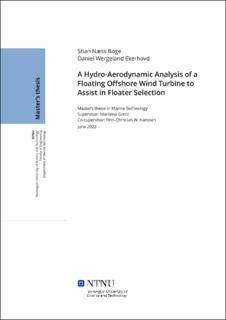| dc.contributor.advisor | Greco, Marilena | |
| dc.contributor.author | Boge, Stian Næss | |
| dc.contributor.author | Ekerhovd, Danial Wergeland | |
| dc.date.accessioned | 2022-10-08T17:19:39Z | |
| dc.date.available | 2022-10-08T17:19:39Z | |
| dc.date.issued | 2022 | |
| dc.identifier | no.ntnu:inspera:106583545:64932356 | |
| dc.identifier.uri | https://hdl.handle.net/11250/3024829 | |
| dc.description.abstract | Various types of floaters have been proposed to support floating offshore wind turbines. The bulk of market activity is in semi-submersibles, where each concept is associated with inherent advantages and disadvantages with respect to the design. This thesis aims to perform a fully coupled time-domain dynamic analysis for two different floater designs in operational and extreme environmental conditions and compare their response features and challenges. Two different second-order hydrodynamic load models were applied in the analysis to investigate the applicability of Newman's approximation compared to a full quadratic transfer function (QTF).
The two selected floaters, INO WINDMOOR and OO-Star, were modelled in GenieE, hydrodynamically analysed in HydroD and lastly imported to SIMA for the fully coupled time-domain analysis. The OO-Star floater was originally designed to support a 10 MW turbine but was, in this thesis, upscaled in order to support a 12 MW turbine. In HydroD, a first and second-order frequency domain analysis was performed with outputs consisting of hydrodynamic coefficients, excitation forces, RAOs, mean drift forces, and QTFs.
The numerical models were successfully verified through the results obtained from the hydrodynamic frequency domain analysis from HydroD and the free decay test performed in SIMA. Added mass and damping coefficients, RAOs, the mean drift force, natural periods and the QTFs were used for the verification. A constant wind test was conducted to ensure that the performance of the wind turbine was correct.
The Utsira Nord area was considered a suitable location due to its high wind speed potential and low distance from the coast. The environmental conditions from this area were obtained and used to define the design load cases for the time-domain analyses. Joint distribution models of wind and waves were used to establish the environmental conditions.
Newman's approximation underestimates the surge, heave, and pitch resonant response compared to the analyses with a full QTF. However, this had a negligible effect on the total response of the two FWTs. Therefore, it was concluded that Newman's approximation is applicable in surge, heave and pitch.\\
The INO WINDMOOR experiences the largest dynamic motions in heave while the OO-Star experiences the largest dynamic motions in surge. The dynamic pitch motion is not consistently larger for either model. The tower on the OO-Star FWT is generally subjected to lower axial loads and bending moments for both operational and extreme conditions. The mooring lines of INO WINDMOOR are subjected to larger tension than the OO-Star, which is due to the larger pretension of the mooring line system for the INO WINDMOOR. Concerning the electrical power output, the INO WINDMOOR is advantageous, however, the differences are quite small between the FWTs. In general, the fatigue damage at the tower, fairlead and different mooring lines segments are more significant for the INO WINDMOOR than the OO-Star. | |
| dc.description.abstract | Ulike typer fundamenter er foreslått til flytende vindturbiner. Hovedtyngden av markedsaktiviteten er "Semi-submersible" fundamenter, hvor hvert konsept har sine fordeler og ulemper med hensyn til designet. Denne oppgaven tar sikte på å utføre en fullstendig koblet dynamisk analyse for to forskjellige fundamenter under operasjonelle og ekstreme sjøtilstander og sammenligne deres respons og utfordringer. To forskjellige andre-ordens hydrodynamiske lastmodeller ble brukt i analysen for å undersøke anvendeligheten av "Newman's approximation" sammenlignet med en full "quadratic transfer function" (QTF).
De to utvalgte flytefundamentene, INO WINDMOOR og OO-Star, ble modellert i GenieE, hydrodynamisk analysert i HydroD og til slutt importert til SIMA for en fullstendig koblet tidsdomeneanalyse. OO-Star fundamentet ble opprinnelig designet for å støtte en 10 MW turbin, men ble i denne oppgaven oppskalert for å støtte en 12 MW turbin. I HydroD ble det utført en første- og andreordens frekvensdomeneanalyse med resultater bestående av hydrodynamiske koeffisienter, RAO-er, eksitasjonskrefter, "mean drift"-krefter og QTF-er.
De numeriske modellene ble verifisert gjennom resultatene oppnådd fra den hydrodynamiske frekvensdomeneanalysen fra HydroD og "free decay"-testen utført i SIMA. "Added mass" og dempnings koeffisienter, RAO-er, "mean drift"-krefter, naturlige perioder og QTF-er ble brukt for verifiseringen. Det ble også utført en vindtest med konstant vind for å sikre at vindturbinen opererte slik den skulle.
Området Utsira Nord ble ansett som et egnet sted på grunn av det høye vindpotensialet og den lave avstanden fra kysten. Miljøforholdene fra dette området ble innhentet og brukt til å definere lasttilstandene for tidsdomeneanalysene. Simultanfordelinger av vind og bølger ble brukt for å etablere lasttilstandene.
"Newman's approximation" underestimerer jag, hiv og trim-responsen ved resonans sammenlignet med analysene utført med full QTF. Dette hadde imidlertid liten effekt på den totale responsen til de to flytende vindturbinene. Derfor ble det konkludert med at "Newman's approximation" er anvendelig i jag, hiv og trim.\\
INO WINDMOOR opplever de største dynamiske bevegelsene i hiv, mens OO-Star opplever de største dynamiske bevegelsene i jag. Den dynamiske trim responsen er ikke konsekvent større for noen av modellene. Tårnet på toppen av OO-Star flyteren utsettes generelt for lavere aksiale belastninger og bøyemomenter for både operasjonelle og ekstreme forhold. Fortøyningslinene til INO WINDMOOR utsettes for større spenninger enn OO-Star, noe som skyldes en større forspenning av fortøyningslinesystemet til INO WINDMOOR. Når det gjelder den elektriske effekten, er INO WINDMOOR fordelaktig, men forskjellene er ganske små mellom fundamentene.
Generelt er utmattelsesskadene i tårnet, festepunktet til forankringslinene og de forskjellige segmentene i fortøyningslinene mer betydelig for INO WINDMOOR enn OO-Star fundamentet. | |
| dc.language | eng | |
| dc.publisher | NTNU | |
| dc.title | A Hydro-Aerodynamic Analysis of a Floating Offshore Wind Turbine to Assist in Floater Selection | |
| dc.type | Master thesis | |
